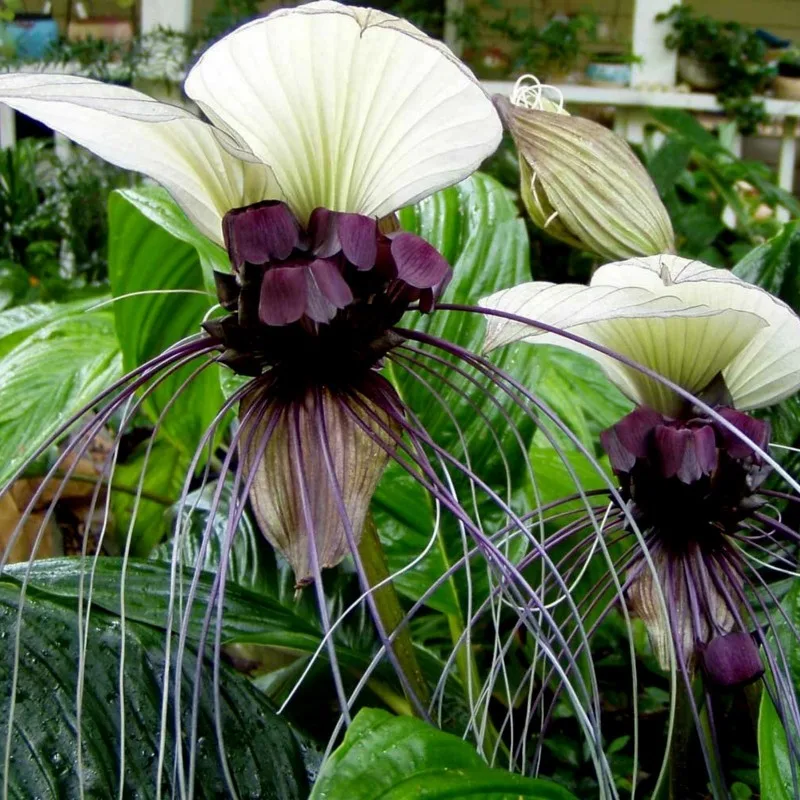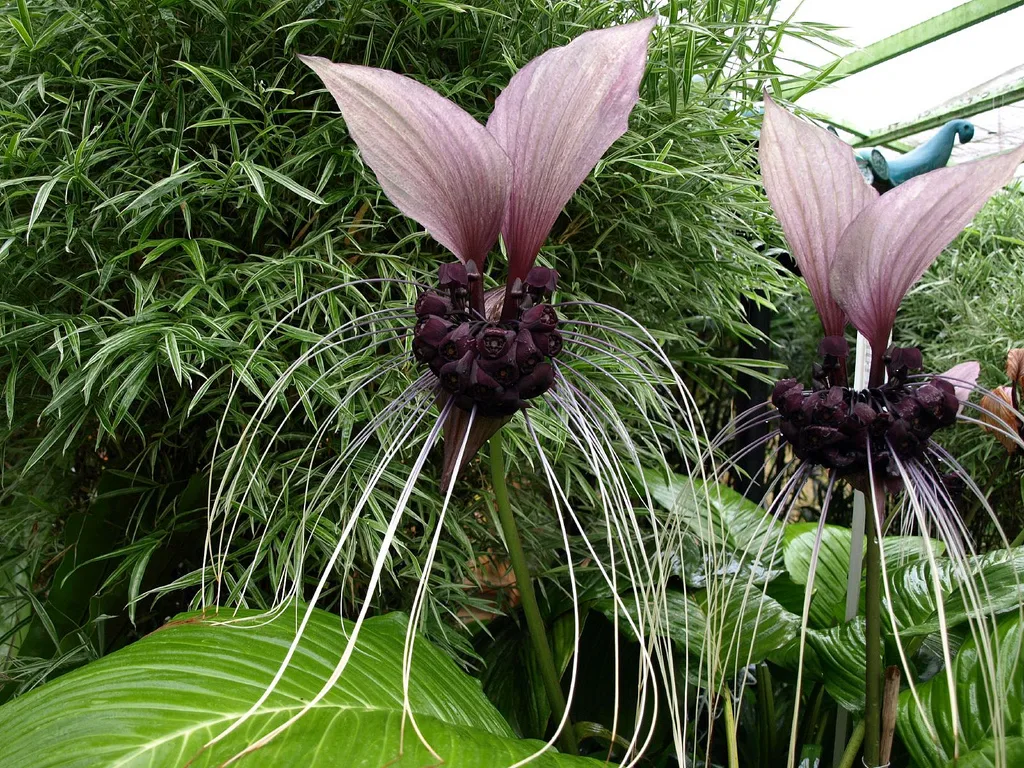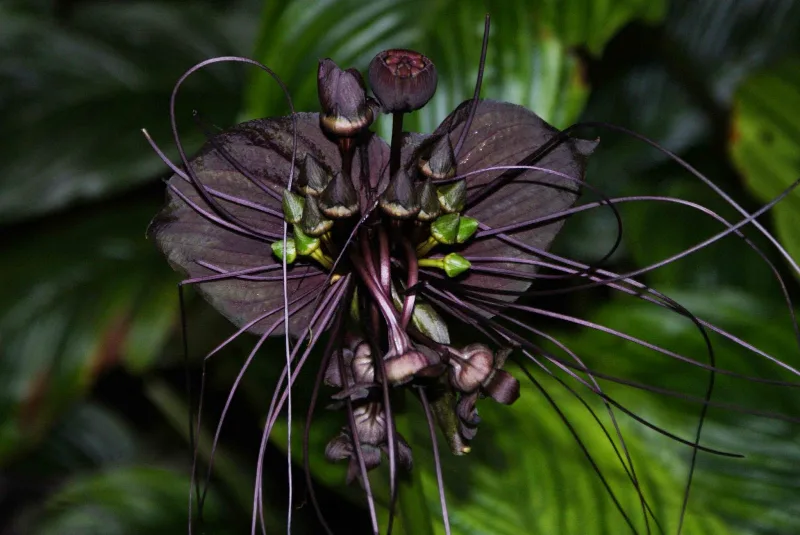Index
Introduction
The Bat Flower, scientifically known as Tacca Chantrieri, is an exotic plant that flourishes in the shady regions of Southeast Asia. With its intriguing name and unique purple and black flowers, it captivates the attention of botanical enthusiasts and ornamental plant lovers all over the world. Its unusual appearance, resembling a bat in flight, gives it a mysterious charm that makes it a fascinating addition to any exotic garden or rare plant collection.
This herbaceous perennial grows to an average height of 60 to 90 centimeters, and its exuberant flowering occurs during spring and summer, providing a dazzling visual spectacle. However, its appeal goes beyond its peculiar aesthetics. In addition to its remarkable appearance, the Bat Flower has a deep symbolic meaning in many Southeast Asian cultures, where it is associated with local legends and beliefs, often considered a symbol of good luck and prosperity.
Meaning of the Bat Flower
According to popular tradition, the Bat Flower is often linked to the idea of renewal and transformation, symbolizing the ability to overcome obstacles and adversity in order to achieve fullness and fulfillment. Its presence in gardens is often considered auspicious, attracting a positive energy that is believed to bring harmony and balance to the environment. In some cultures, its exotic flowers are also associated with spiritual practices and healing rituals, being used in special ceremonies and celebrations to promote well-being and spiritual protection.
| Common Name | Bat Flower |
|---|---|
| Botanical Name | Tacca Chantrieri |
| Family | Dioscoreaceae |
| Plant Type | Herbaceous perennial |
| Size Adult | 60-90 cm |
| Sun exposure | Partial shade |
| Soil type | Moist, well-drained soil |
| soil pH | Acidic to neutral (6.0-7.0) |
| Flowering Season | Spring and summer |
| Flower color | Purple and black |
| Native Area | Southeast Asia |
| Toxicity | Highly toxic |

How to Care for the Bat Flower
The Bat Flower, with all its eccentricity and beauty, requires specific care to ensure its healthy and long-lasting flowering. Here are some essential guidelines for caring for this exotic and enchanting plant.
Light
Although the Bat Flower can be grown in areas with indirect sunlight, it is essential to provide it with a predominantly shaded environment. Exposing this plant to long hours of direct sunlight can result in burns on the leaves and harm its healthy development.
Soil
The ideal soil for the Bat Flower should be well-drained and slightly moist. We recommend using substrates rich in organic matter, which helps to maintain the right level of humidity and provide the nutrients needed for the plant to grow vigorously.
Watering
Proper watering plays a crucial role in the care of the Bat Flower. It is important to keep the soil evenly moist, but not soggy. Avoid overwatering, as the accumulation of water can lead to root rot, resulting in irreversible damage to the plant.
Temperature and humidity
The Bat Flower prefers environments with moderate temperatures, generally between 18°C and 25°C. In addition, it is essential to ensure adequate relative humidity, especially in regions with a drier climate. Spraying the leaves regularly can help maintain the necessary humidity around the plant.
Fertilizing
To promote healthy growth and lush flowering, it is advisable to apply balanced fertilizers during the active growing season. Choose a fertilizer rich in essential nutrients, such as nitrogen, phosphorus and potassium, and follow the application instructions according to the Bat Flower‘s specific needs. Remember not to exceed the recommended doses, as too much fertilizer can harm the plant.
What Types of Bat Flower
The Bat Flower, with its exotic and intriguing appearance, has several varieties that delight plant lovers all over the world. Here are some of the most notable types of this fascinating species:
- Tacca Chantrieri: The most common variety, known for its deeply colored flowers, which vary from shades of deep purple to black, giving it a striking and mysterious presence.
- Tacca Integrifolia: This variant has flowers in softer tones, with a combination of white and pale violet, creating a delicate and elegant contrast compared to the darker-toned varieties.
- Tacca Cristata: Recognized for its lush and distinctive flowers, which resemble a crest or crown, Tacca Cristata is often appreciated for its unique shape and for adding a fascinating ornamental element to any green space.
- Tacca Plantaginea: This variety stands out for its large, lush leaves and light, soft flowers, which add a touch of serenity and delicacy to any garden or indoor environment.
Each of these variants has its own striking characteristics, adding diversity and beauty to this enchanting family of plants. Whichever you choose, the Bat Flower is sure to impress with its unique and exotic appearance.

How to Prune the Bat Flower: Importance and Techniques
Proper pruning plays a crucial role in the care and healthy maintenance of the Bat Flower. Regular pruning not only promotes the plant’s robust growth, but also helps to maintain its shape and stunning appearance. Here are some essential tips for pruning the Bat Flower:
- Removing Dead and Damaged Leaves: Regularly remove dead and damaged leaves to stimulate the healthy growth of new shoots and ensure that the plant retains its vitality.
- Cutting Wilted Flowers: By removing wilted flowers, you encourage the plant to focus its energy on developing new flower buds, thus prolonging the flowering period.
- Size control: Careful pruning helps to control the size of the Bat Flower, preventing it from growing in a disorderly manner and maintaining its aesthetically appealing shape.
How to Cutt the Bat Flower
To propagate the Bat Flower, the cuttings propagation technique is one of the most effective. Here is a basic guide on how to make cuttings from this lovely plant:
- Choosing Cuttings: Select healthy, robust cuttings, preferably those with three or more leaves to ensure a higher propagation success rate.
- Preparing the soil: Prepare a light, well-drained substrate rich in nutrients to provide the best growing environment for the cuttings.
- Planting the cuttings: Plant the cuttings in individual containers, ensuring that they are firmly fixed in the soil, and keep them in a place with indirect light.
- Adequate watering: Keep the soil slightly moist, avoiding waterlogging, and provide the right amount of water to stimulate healthy rooting of the cuttings.
How to Plant the Bat Flower Step by Step
When planting the Bat Flower, it is crucial to follow the proper steps to ensure its healthy and robust development. Here is a step-by-step guide to effectively planting this exotic plant:
- Preparing the Soil: Make sure you prepare suitable, well-drained soil rich in organic matter that meets the specific needs of the Bat Flower.
- Choosing a suitable location: Select a shady or partially shady spot, avoiding direct exposure to intense sunlight, to create an environment conducive to the plant’s healthy growth.
- Suitable Planting: Plant the Bat Flower at a depth that allows the roots to attach securely and guarantees the plant’s stability in the soil.
- Watering and Maintenance: Water the plant regularly, keeping the soil evenly moist, and carry out appropriate maintenance, such as removing weeds and applying fertilizer as necessary, to ensure vigorous growth and lush flowering.
Most common pests and diseases
When growing the Bat Flower, it is essential to be aware of a number of pests and diseases that can negatively affect its healthy growth. Here are some of the most common pests and diseases that can affect the Bat Flower:
- Mealybugs: Small insects that suck the plant’s sap, resulting in spots and general debilitation.
- Mites: Microscopic creatures that can cause damage to the leaves, resulting in yellowing spots and curling of the edges.
- Root rot: A condition caused by excess moisture in the soil, which leads to rotting of the roots and, consequently, a deterioration in the general health of the plant.
- Fungus: Fungal infections can lead to the appearance of dark spots on the leaves and flowers, compromising the appearance and vitality of the Bat Flower.

Common Problems and Their Solutions
In order to deal effectively with the problems that can arise during the cultivation of the Bat Flower, it is essential to adopt appropriate prevention and solution measures. Here are some solutions to common problems that can affect the plant’s health:
- Pest Control: Use organic pest control methods or specific products to eliminate infestations of mealybugs and spider mites without harming the plant.
- Soil Moisture Management: Regularly monitor soil moisture and avoid overwatering, ensuring that the soil has good drainage to prevent the development of root rot.
- Fungicides: Use appropriate fungicides to treat fungal infections and avoid excess moisture around the leaves and flowers to reduce the likelihood of fungi spreading.
Advanced Care and Maintenance Tips
In addition to combating pests and diseases, advanced care and regular maintenance are essential to ensure the healthy growth and longevity of the Bat Flower. Here are some tips for advanced care:
- Regular Monitoring: Make regular inspections for signs of problems and treat them promptly to avoid serious damage to the plant.
- Controlled Fertilization: Apply slow-release fertilizers to ensure a constant supply of nutrients without overloading the plant with excess fertilizers.
- Suitable Environment: Keep the Bat Flower in an environment with good air circulation and controlled humidity levels to minimize the risk of infestations and infections.
Curiosities and myths
The Bat Flower is not only an exotic and stunning plant, but it is also shrouded in a series of curiosities and myths that make it even more fascinating. Here are some interesting facts and myths associated with this enigmatic plant:
- Night Flowers: One of the most intriguing characteristics of the Bat Flower is its preference for flowering at night, attracting nocturnal pollinators such as moths and bats, which are essential for its reproduction cycle.
- Cultural Legends: In many Southeast Asian cultures, the Bat Flower is associated with a variety of legends and beliefs, often considered a symbol of good luck, prosperity and spiritual protection against negative energies.
- Special Adaptations: Its unique structure, which resembles a bat in flight, is not only aesthetically impressive, but also plays a crucial role in attracting specific pollinators that are essential for its reproduction.
- Cultural significance: In some communities, the Bat Flower is used in spiritual practices and healing rituals, with its exotic flowers believed to have protective and purifying properties that can ward off negative energies and promote spiritual well-being.
- Genetic Variations: The different variants of the Bat Flower, with a wide range of colors and shapes, are the result of genetic variations that contribute to its impressive diversity and its popularity among plant collectors and gardening enthusiasts.
These curiosities and myths reflect not only the complexity and beauty of the Bat Flower, but also the rich cultural tapestry that surrounds it, making it a truly captivating plant and unique in its charm.

Conclusion
In conclusion, the Bat Flower represents much more than just an exotic plant. Its mysterious and enchanting presence transcends cultural boundaries, inspiring myths and legends that highlight its deep symbolic meaning in various communities. In addition to its exotic beauty and impressive flowers, the Bat Flower requires specific care, from the right choice of soil and light to careful maintenance to prevent pests and diseases.
Throughout this guide, we explore not only the practical aspects of growing and caring for the Bat Flower, but also delve into the curiosities and myths surrounding it, highlighting its cultural importance and aesthetic appeal. With its nocturnal flowers and fascinating symbolism, the Bat Flower continues to fascinate and captivate plant lovers and nature enthusiasts, securing its place as one of the most intriguing and enigmatic species in the plant kingdom.
Frequently Asked Questions
How to care for Tacca Chantrieri?
To care for Tacca Chantrieri, the most common variety of bat flower, follow these guidelines:
Light: Keep it in partial shade.
Soil: Use well-drained soil rich in organic matter.
Watering: Keep the soil evenly moist, avoiding waterlogging.
Temperature: Keep the plant in rooms with temperatures between 18°C and 25°C.
Fertilizing: Apply balanced fertilizers during the period of active growth.
What are the colors of the bat flower?
The color of bat flowers varies between different varieties, but the most common colors include:
Purple: The predominant color, often in deep shades.
Black: Often combined with purple, creating an exotic effect.
White: Some varieties have white flowers or white details.







